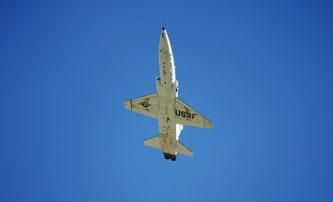http://www.heraldandnews.com/articles/2006/08/29/news/local_news/local2.txt
Birds, planes collide too
often
H&N photos by Todd E. Swenson A T-38 military
jet takes off from Kingsley Field Monday. This
and other aircraft, such as the Oregon Air
National Guard’s F-15s and Horizon’s commuter
planes, are placed in jeopardy if and when they
strike birds near the airfield. |
 |
August 29, 2006
When a bug hits a car windshield, it can be messy
but it's generally not dangerous. But when a bird
hits an airplane, the pilot's heart stops.
Birds and airplanes have collided too many times at
the Klamath Falls International Airport near
Kingsley Field. Corporate jets, Horizon planes and
fighter jets routinely fly in and out of the
airfield.
So do Canada geese, ducks and other birds.
$4.2 million project
Which is why airport officials have started a
$4.2-million project to decrease wetlands - and
therefore the number of birds - near the airport.
“Birds around aircraft is a big safety issue,” said
Ann Crook, director of the Klamath Falls airport.
“We've had real problems with all of the birds that
are attracted to the water around the airport.”
The loss of wetlands will be mitigated by adding
wetlands at other sites.
Eight birds struck aircraft in 2004 and 2003, and
there were 11 bird-plane collisions in 2001, Crook
said.
The incidents included several Canada geese that
struck a corporate jet, a goose that hit a propeller
and wing of an airline flight and a duck that hit a
commercial flight's windshield.
Geese often weigh 10 pounds or more. Ducks are
smaller. Many waterfowl live in the Klamath Basin
and many more migrate through it.
Past bird-plane collisions caused damage to
aircraft, Crook said, but didn't cause any accidents
or injuries to crew or passengers.
In a 2003 document, the Federal Aviation
Administration said that between 1990 and 1999, that
there were 2,612 bird-plane collisions nationwide,
458 involving geese, 166 involving ducks and 182
involving hawks. Geese, ducks and hawks are common
Klamath Basin birds.
The $4.2 million for the Klamath Falls airport will
fund a three-part environmental mitigation plan. The
first phase, funded by a 2004 FAA grant, was used to
study wildlife around the airport and develop a
plan.
The next phase will include construction to
alleviate the problem.
“That will be cleaning out the drain that runs along
the east side of the airport,” Crook said. “And it
will mean installing a pump in the Klamath
Irrigation Pond. We expect work to start and finish
later this fall.”
Estimated to cost $2.5 million, a third phase is
scheduled to start next year.
“The Air National Guard has also given us $700,000
because they realize that this is a problem for them
too,” Crook said. “But we are still waiting on
Congress to approve the funds next year.”
Crook said the final aspect project will include an
environmental assessment and drainage of some of the
wetlands surrounding the airport.
“(It) will focus on eliminating ponds,” she said,
“and it will entail getting wetland mitigation
permits for state lands from the state and the U.S.
Army Corps of Engineers.”
By GERRY BAKSYS
H&N Staff Writer
This email was cleaned by emailStripper, available
for free from http://www.papercut.biz/emailStripper.htm |

